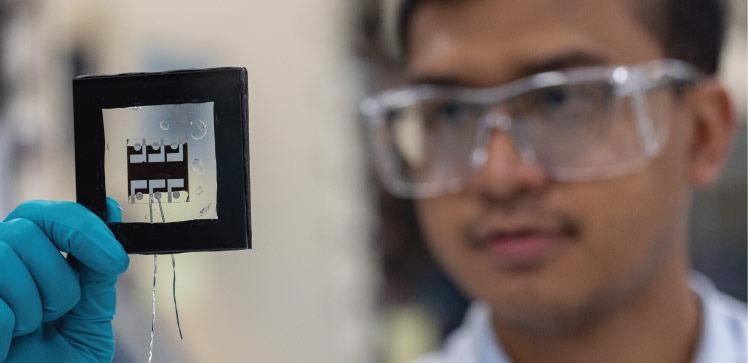KAUST researchers have developed multilayered perovskite-based coatings that protect high-performance perovskite solar cells from excessive heat and moisture while also improving their long-term stability, which is an important step toward device commercialization.
 KAUST scientists have developed a film that protects perovskite solar cells from adverse conditions such as high temperatures and moisture, boosting their long-term stability. Image Credit: © 2022 King Abdullah University of Science and Technology.
KAUST scientists have developed a film that protects perovskite solar cells from adverse conditions such as high temperatures and moisture, boosting their long-term stability. Image Credit: © 2022 King Abdullah University of Science and Technology.
Perovskite solar cells have emerged as the fastest-growing alternative to the photovoltaic market’s dominant silicon technology. They have shown tremendous continuous growth in performance, perhaps exceeding their silicon-based counterparts. They are cheaper and easier to fabricate. However, the light-responsive perovskite film’s stability is harmed by intrinsic surface flaws and ion migration, a phenomenon that gets more prominent at higher temperatures.
The three-dimensional (3D) perovskite film, sandwiched between charge carrier-selective materials, turns light to energy by producing pairs of electrons and positively charged holes. Electrons travel toward the “n-type” layer whereas holes migrate toward the “p-type” layer after charge separation and collection, resulting in an electric current.
Under temperature stress and external circumstances such as fluctuating moisture and oxygen, two-dimensional (2D) perovskites are more robust than their three-dimensional (3D) counterparts. A heterojunction is formed by growing a 2D perovskite layer on top of a 3D perovskite film, which prevents ion migration as well as moisture and oxygen.
These 2D perovskite capping layers further increase the resilience of uncapped devices to high moisture and heat stress similar to that found in the outdoors.
While this top-contact passivation method has improved the performance and stability of conventional solar cells with the p-type layers on top, it has so far been unable to improve the performance and stability of inverted solar cells with the n-type layers on top.
External conditions are not an issue for a sealed device but the intrinsic thermal instability of the perovskite film remains problematic.
Randi Azmi, Study Lead Author, King Abdullah University of Science and Technology
Randi Azmi is a member of Stefaan De Wolf’s group.
Taking this idea a step further, Azmi, De Wolf, and their colleagues showed that controlling the number of inorganic sheets, or dimensionality, of the 2D perovskite material, was critical for successful top-contact passivation.
At the n-type interface of inverted solar cells, the researchers created heterojunctions comprising 2D perovskites of different dimensionalities. Researchers used the cation precursor oleylammonium iodide to generate the 2D layer in situ on the 3D film and left it to self-organize overnight at ambient temperature.
When heterojunctions using 2D perovskites had a dimensionality of two, they were demonstrated to significantly improve device performance and stability. The gadgets have a 24.3% power conversion efficiency. They also met a major industry stability criterion for solar modules after more than 1,000 hours under accelerated high-humidity high-temperature test conditions, retaining more than 95% of their initial value.
The team is now designing new molecules for 2D perovskites to develop ultrastable inverted perovskite solar cells with efficiencies close to those of regular devices that exceed 25%.
Randi Azmi, Study Lead Author, King Abdullah University of Science and Technology
A tailored coat to beat the heat
KAUST scientists are developing technology to boost the performance and stability of perovskite solar cells. Video Credit: © 2022 King Abdullah University of Science and Technology.
Journal Reference:
Azmi, R., et al. (2022) Damp heat–stable perovskite solar cells with tailored-dimensionality 2D/3D heterojunctions. Science. doi.org/10.1126/science.abm5784.